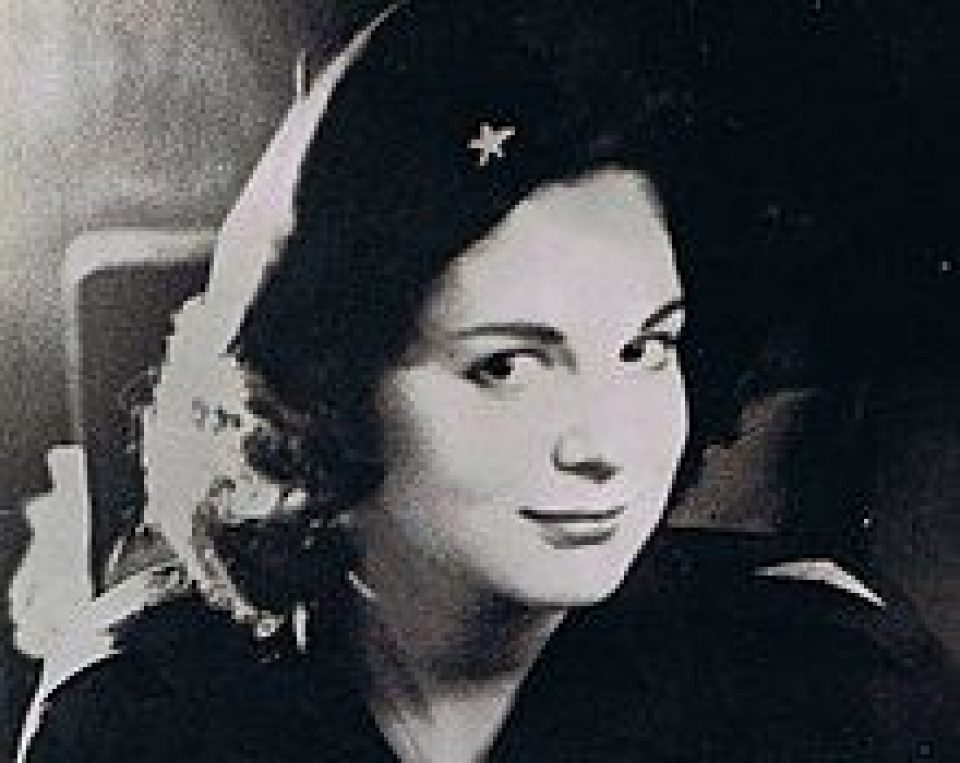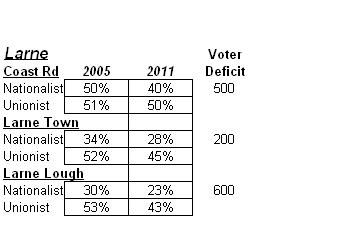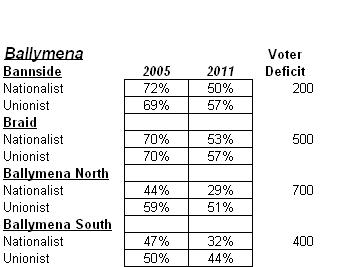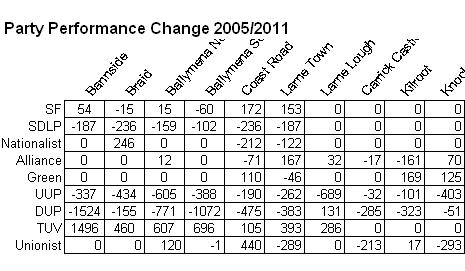Next up in Faha’s series is the most Unionist County in Ireland. Antrim. Specifically the “Bible Belt” new council of Mid and East Antrim.
This 7th analysis of the new district councils will cover the new Mid and East Antrim  council. This new council comprises all of the current Ballymena, Larne and Carrickfergus councils. The demographic breakdown is 19.34% Catholic, 72.88% Protestant, 0.8% Other and 6.97% None.
council. This new council comprises all of the current Ballymena, Larne and Carrickfergus councils. The demographic breakdown is 19.34% Catholic, 72.88% Protestant, 0.8% Other and 6.97% None.
The following shows the change in the turnout for the nationalist and unionist parties comparing the 2005 and 2011 district council elections.
There were no nationalist candidates in all the Carrickfergus DEA’s and Larne Lough DEA. I used the Assembly results to estimate the 2011 turnout as well as turnout in adjoining DEA’s. The election turnout for the 2005 and 2011 elections indicate:
#1 There was a steep decline in turnout between the 2005 and 2011 elections.
#2 Unionist turnout is much higher than nationalist turnout in 8 of the 10 DEA’s. In the other 2 DEA’s, Bannside and Braid, it was slightly higher in the 2011 election.
#3 Almost 3,000 additional nationalist voters would have had to vote in 2011 in order to equal unionist turnout.
#4 In the 2011 Assembly election, nationalist voter apathy (1,400 voter deficit in the Ballymena DEA’s and an additional 300 deficit in Ballymoney Town) resulted in the election of Jim Allister to the Assembly for North Antrim. Jim Allister defeated Decaln O’Loan of the SDLP by only 613 votes.
#5 In the 2011 Assembly election, nationalist voter apathy (1,500 voter deficit in Larne and Carrickfergus) almost resulted in no nationalist representation for East Antrim. The SF MLA was elected with 3,388 votes, 759 votes short of a quota and only 498 votes ahead of a UUP candidate. It was only because 655 DUP and TUV votes that were nontransferable that the UUP candidate was not elected. The census shows 1.56 nationalist quotas based on voting age population.
The percentage change in the party vote between 2005 and 2011 is as follows:
In Ballymena, the SF vote held steady but the SDLP vote collapsed. There was a large increase in the nationalist electorate but all these additional voters did not vote. The UUP and DUP vote also collapsed. The UUP voters stayed home and the DUP voters mainly defected to the TUV. In Larne, the SDLP and independent nationalist vote was down, with some of these voters accounting for the increased SF vote. A sharp decline in the UUP and DUP vote here also with the UUP voters staying home and the DUP voters defecting to the TUV. The Alliance Green vote has changed little in Larne and Carrickfergus. There was a large decline in the unionist vote for all parties in Carrickfergus.
The new DEA’s bear some resemblance to the old ones (see map). The towns of Ballymena and Larne are divided between 2 DEA’s and the town of Carrickfergus between 3 DEA’s. The predicted election results are based on the 2011 turnout.
The average ward electorate is 2413. The total electorate and average ward electorate for each DEA is.
Bannside 14058 (2343)
Braid 16551 (2364)
Ballymena 15657 (2237)
Coast Road 12435 (2487)
Larne Lough 12848 (2570)
Carrick Castle 12886 (2577)
Knockagh 12090 (2418)
The current Ballymena, Larne and Carrickfergus district councils had the following party makeup after the 2011 elections.
SF 3 SDLP 3 Alliance 7 UUP 11 DUP 24 TUV 3 Unionist 5
Total 56
The expected party strength in the new council with the new DEA boundaries:
SF 3 SDLP 2 Alliance 4 UUP 9 DUP 20 TUV 2
Total 40
The new council will have 16 fewer councilors and the net party loss would be.
SF 0 SDLP -1 Alliance -3 UUP -2 DUP -4 TUV -1 Unionist -5
This council will be dominated by a hard line unionist majority- the DUP and TUV. The TUV could win a seat in Braid DEA at the expense of the UUP, depending on if the size of the nationalist surplus that could transfer to the 2nd UUP candidate. It is possible that an independent unionist could be elected in 1 of the Carrickfergus DEA’s but the increased electorate and increased quota will make it difficult for the election of any independents. The DEA boundaries are actually favourable to the nationalist parties. Despite 16 fewer councilors SF should return the same number with 1 less for the SDLP. There are over 2 nationalist quotas in the Coast Road DEA and if the nationalist turnout ever equals unionist turnout the SDLP would have a seat here. If the SDLP and SF decide to stand candidates in the Larne Lough, Carrick Castle and Knockagh DEA’s, and nationalist turnout equals unionist turnout, then tactical transfers could elect 2nd Alliance candidates in all 3 of these DEA’s. In Ballymena DEA, SF could elect a councilor if they ever organize here. This would be at the expense of the SDLP or a unionist in future elections. While this will always be a unionist dominated council, it is possible that with additional nationalist councilors in Ballymena and Coast Road and additional Alliance councilors in the 3 other DEA’s mentioned, the DUP and TUV would not have a majority on the council.






The town of Carnlough is the centre of nationalist strength due to the concentration of Catholics in the town, Oliver McMullan stunned even SF when he won the seat in East Antrim, (Danny O’Connor did fluke it before right enough), as shown by him running in both assembly and council elections, Winning both he gifted his council seat to James McKeown.
In my view the SDLP once again shot itself in the foot. They did not back Danny O’Connor, Danny had an advice centre in Carnlough and was well known, he had his vote but instead they ran Justin McCamphill. Nothing wrong with Justin however he was relatively unknown in Carnlough despite his relations there. So he was fighting on the back foot against a very strong SF team. Whether Danny would have done better can be argued but for my money the better bet would have been Danny.
The southern Glens are not shinner territory. Unlike Glenarriffe, SF’s best performing Glen it is more defender than republican. SF outside of the Carnlough/Glenarm and in parts of Ballymena have not made headway . In Larne they are not registering. Carnlough has been more SDLP than SF and I am not sure if SF can hold the seat if they were facing a strong local candidate. Also combine that with the areas reputation for supporting independants, Frank O’Neill, Willie Cunning in the past, SF might find it hard to develop this area.
Not that they are not trying. Caral Ni Cuilin will have visited the area twice this month to support local groups seeking grants for example but the turnout and take up of tickets for the recent dinner do was not encouraging as was the proposals to take money away from the local schools to fund the schools of Belfast. It has always been a source of irritation not being in with the rest of the Glens and this has been exasperated by SF selling out of the nationalists throughout the Glens in in the recent super council carve up.
Alliance always tends to get a rep in. They always get a good transfer from nationalist tactical vote and around the Ballygally area they get the noice votes. Interesting to see if Anna Lo has made any impact here, I would expect a decline in unionist vote without any compensatory nationalist increase.
The Ulster Unionists are pretty solid, the emergence of Maureen Morrow was good for them, she is both well known and liked in the area and they were astute enough to give Maureen plenty of exposure as Mayor of Larne to ensure she ahs the best hance of retaining her seat. A local girl who knows local people, not gaffe prone, is hard to beat.
The DUP of course are strong, cannot see the TUV impact much here, if Tommy Robinson could not do it no one will.
All in all, from a coast road prospective, the only thing worth watching is whether the increasing dissatisfaction with SF lead to more nationalist decline or not. SF may be in for a shock, they could easily lose here, especially if the rumours about either a local well known and respected Fianna Failer with strong family links to Larne as well as Carnlough makes his move or another independent raises his head. For SF’s sake it would be better if this did not happen as it would split the vote and no nationalist would be returned.
LikeLike
sinn fein are stronger than ever in carnlough, just wait and see the results when they come in , sure bet 🙂
LikeLike
Croiteir,
Thank you for your comments. It is always helpful to have someone with detailed local knowledge give their insight.
LikeLike
It was mostly wrong though. I don’t think he’s ever set foot in the Glens…
LikeLike
By the way keep an eye out for a surprise candidate in Ballymena
LikeLike
And the boul Danny has been speculating about running as an independant
LikeLike
Couple of things, Faha; Larne and Carrick have 2 DEAs, Ballymena has 3. Also, IIRC, this will give 10 councillors each for Larne and Carrick and 20 for Ballymena, which will lead, I think, to some interesting dynamics to do with local politics. I can see the East Antrim councillors uniting to oppose the centre of gravity that is Ballymena here.
While SF won the last Assembly seat (a gain off the UUP who had a long-time incumbent retire with his replacement being a Tory-lite), this may give them the lift needed to boost voter numbers. In Carrick, the councillor choices are going to lead to some pretty interesting results and I think that an independent does have a chance – Jim Brown is well known. DUP have been courting some interesting characters, not sure if he is standing but Fred Cobain, formerly UUP whip at Stormont, has been lurking in the background for the past year now in local papers. There are also a couple of PUP candidates in Knockagh and one in the Castle new DEAs. Can’t see them getting elected.
One thing that I have to point out is the painfully low voter turnout in the old Carrick Castle wards – this is the town centre, Sunnylands and Woodlawn estates plus a handful of private developments spread out over a large area. In all my time in Carrick, I’ve only ever had my door knocked by the UUP and DUP so haven’t had the opportunity to hunt the TUV or Alliance. Maybe that’ll change this time round but I doubt it.
LikeLike
So I called Jim Brown’s election, PUP’s non-election and SF getting a Larne seat. Low voter turnout of 49% for the entire council area would point to lower than that in Carrick – be interesting to see the figures broken down.
LikeLike
Faha, excellent stuff as usual.
Croiteir, likewise excellent detail.
Most (simplistic) analysis of the Nat vote (including my own) tends to see the SDLP as attracting more-middleclass and older voters than SF – but clearly class, age profile and strength of local party candidates is not sufficient to explain why the increase in strength of SF is not always as might be predicted – in certain areas.
Is there another factor that I’m missing?
LikeLike
Do youse think NI21 have a chance here, and what do you think of NI21’s chances generally where are they likely to do best?
LikeLike
I have not heard anything from them, so I would not think so unless in Carrick?
LikeLike
NI21 have no chance. No known candidates and Alliance in Carrick more likely to pick up the soft unionist votes/soft nationalist votes.
LikeLike
Danny O’Connor has thrown his hat in the ring – as an independant
LikeLike
O’Connor may be relatively well known in Larne, but he always found it difficult to attract votes from the relatively dispersed catholic population, especially since many live in working class loyalist estates and run around wearing Rangers shirts with their UDA pals (yes, only in Larne).
Despite being overwhelmingly Catholic, the people of Carnlough were never quite enthused with Danny (Carnlough has very low turnout even by East Antrim standards) and it is certainly more in the Moyle/Ballymena orbit rather than Larne, despite being officially in the latter borough. It was no suprise to me that Sinn Fein finally cottoned on to this and ran an experienced candidate from down the Glens direction.
LikeLike
The “many” Catholics running about in Rangers shirts are about half a dozen drug dealers mostly from mixed families. Don’t believe everything you read in the press…
LikeLike
As for the DEA’s of my council:
Larne Lough is basically the same, with a bit extra of the town itself and Whitehead added on. The only difference I see is a slightly higher alliance vote though not enough to change the 2DUP, 2UUP, 1ALL elected order. The Beggs family name still carries some weight for the Old Guard in the likes of the Glynn and the Raloo area where the family is steeped in the local farming community. Beggs Snr the former MP is likely to stand for council again and this should ensure the DUP don’t nick a 2nd seat from them.
The other DEA consisting of the majority of Larne town along with Carnlough and Glenarm will be a fragmented scene as always. Sinn Fein and Alliance look likely to be elected along with 3 unionists, I’d guess 1 TUV, UUP and DUP. Though I wouldn’t discount Independent Roy Craig displacing the Ulster Unionist (he walks on the Twelfth so we shall assume he has a basically unionist world view).
LikeLike
Thanks for that Martin, excellent local knowledge!
LikeLike
It seems the hustings have turned muscular already.
LikeLike
I see that intellectual giant Mike Nesbitt has sent out a plea to Peter Robinson to go easy on the UUP at the locals & the Euros. He specifically talks up UUP candidates in East Antrim but, interestinglu, says Belfast is a long term project. Sounds like a man resigned to playing second fiddle for a very, very long time.
http://www.belfasttelegraph.co.uk/news/politics/ulster-unionist-leader-mike-nesbitt-backs-pact-among-unionists-in-may-elections-30139742.html
LikeLike
Another update – Sean Waide is running in the Larne Lough area for SF, personally I believe it would be better for SF to run Waide in the Coast Road area, although not from Carnlough he has reared his family there and is a popular person and run McKeown in Larne, (I believe McKeown is originally a Larne man), in reply to Martin Lemon and running a SF from the Glens, SF knew that Carnlough is very much on the periphery of Larne and have ran Carnlough people there before, up to now Carnlough was not shinner territory and it was only by sheer hard work McMullan got in, they still have a very tenuous grasp on the area, it could well move away if a strong alternative was available. Also remember that there strategist par excellance McKillop from the middle Glens has left last November and thathas severely damaged their capacity in the general Glens area. If she should defet to the stoops it would make the middle Glens vulnerable too. SF are not the traditional party of the Glens, this is ribbonmen territory not republican and certainly not abortion supporting socialist republicans.
LikeLike
dont know were you get that daft information from, were people are from and live, your wrong anyway , regards james mc keown, half the councilors running in the 6 counties , were reared up as you say somewere else , sinn fein has been getting a increasing vote in the coast rd,in the last few elections, and there is more to come, carnlough has played a big part in that, as its the largest catholic /republican ward , in the coast road,and james mc keown has worked hard, along with a good support team to keep it that way
LikeLike
Sean what was daft about giving background information on the candidates? I believe that Waide would have been better in the Coast Road and McKeown in Larne, they would not have lost any votes that way and may well hve gained some. I did say that SF were getting more votes, however they do have a tenuous grasp, they had no real opposition for the nat vote with a weak candidate in Martin Wilson and Danny O’Connor slugging it out for the opposition nat votes and even then there was not much of a difference between SF and the two rival nats votes. Hardly a ringing endorsement, note that it took until the 6th count to get SF over the line. Carnlough has indeed played a big part in that, south of the Southern Glens of Glenarm and Glencloy (Carnlough), SF have no organisation to talk of until you get to Bawnmore. And as for the support team, locals know the desperation to get bums on seats at the dinner in Sootys.
LikeLike
Larne’s divided into 2 wards now rather than 3. Waide was looking for votes mostly in Glynn, Islandmagee etc etc and never had a chance. Most “catholic ” areas in Larne were in the Coast Rd ward. Just look at the votes cast…
LikeLike
You are reinforcing what I have said – we all realisethat Waide was on a forlorn hope, but that forlorn hope would have had better gains with McKeown coming from Larne than Waide.
LikeLike
Croiteir – have you ever actually been to Carnlough or Larne. Almost every word of your ” analysis ” is wrong as the election results showed. Also there is no such entity as South Glens, Mid Glens etc. Stop making things up…
LikeLike
Lived in the area all my life, as for the definitions above for your erudition tey are commonly used to denote the divisions between the glens. Carnlough/Glenarm, Southern, Watefoot to Cushendun, middle, and Ballycastle northern. Nice to be able to share knowledge. Do not rush to thank me.
LikeLike
As have I and never heard these terms in my life. You made them up.
LikeLike
The pdf below uses the term in its introduction,I have also added some results of a google search for middle glens, could not be arsed to go further, I feel I have done more than duty calls for to enhance your deficient knowledge of the area and its terminology – are you sure you come from here?
Click to access ccg_glens_antrim.pdf
http://www.glensbusiness.com/about-us
Middle Glens Exhibition: Completed 14 exhibition panels on ‘Life in the Middle Glens’ which are portable, but currently on display in the Old School House, Cushendall.
http://www.danielmcalisterandson.com/pages/about
Situated in the heart of the Glens of Antrim within the picturesque setting of Cushendall, an area renown for its outstanding natural beauty, Daniel McAlister & Son are the only Estate Agents based in the middle glens of Antrim
http://www.cushendallcottages.com/the_nine_glens_of_antrim.php
Gleann Corp, The glen of the slaughtered
A fierce battle was fought in the area of the middle glens (Glen Ballyeammon to Glendun) in 1559 between the McDonnells and the MacQuillans. The MacQuillans had cavalry, but before the battle the McDonnells dug pits in the boggy land and covered them with heather and grass. The mounted soldiers fell in to the trap and so the McDonnells won the Battle of the Boglands.
LikeLike
Yes I am sure and I’ve still never heard anyone outside of some marketing blurb actually say those terms. Anyway it’s over now I’ll let you win …
LikeLike
A win I will graciously accept
LikeLike
Your election analysis was still completely pants tho…
LikeLike
It was entirely accurate
LikeLike
You are right- McKeown is indeed originally from Larne but moved to Carnlough at some point in the last 15 years. I believe his house in Craigyhill was petrol bombed.
He achieved a very decent vote in this election considering Sinn Fein’s weakness in Larne town itself. A strong vote in Carnlougj and parts of Glenarm no doubt made up a big proportion of his total vote
LikeLike
Correct – but nothing to be happy about
LikeLike
Pingback: The 11 new district councils – projecting the 2011 votes « Slugger O'Toole
Really good job Faha well worth the read.
Just one or two little points for Ballymena.
The UUP wont win two in Braid I suspect they might lose their seat in Ballymena town as they have lost some key areas to the Bannside DEA.
SF will gain a seat in Ballymena Town and this will reduce SDLP to two seats losing PJ McAvoy to retirement was a bad blow for the SDLP.
TUV wont win a seat in Ballymena Town I think Alliance have just enough to retain theirs just and the DUP will take 4.
Just my opinion though
LikeLike
How wrong you were: SF losing out, SDLP retaining a seat.
The full line-up in Ballymena DEA is – J Henry (Ind), O’Loan (SDLP), A Wales (DUP), Anderson (TUV), Carson (DUP), Glover (DUP) and S Nicholl (UUP).
LikeLike